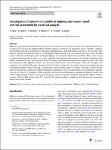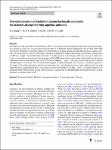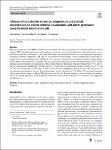Search
Author
- Bahadar, A. (1)
- Esmaeel, Sh. M. A. (1)
- Garbely, Anja (1)
- Hagag, M. S. (1)
- next >
Subject
- ArcGIS 10.5 (1)
- CGIAR (1)
- Chengyu Region (1)
- COD (1)
- next >
Has File(s)
- true (6)
Search Results
Highway stormwater runoff pollution has become a severe risk factor for water bodies nowadays. The conventional risk analysis protocols for directly discharging highway runoff are prone to systematic and judgmental errors. Therefore, a numeric and straightforward risk assessment protocol has been developed in this study that minimizes the errors. For this study, three highway segments were selected in the city of Rawalpindi, Pakistan. Event mean concentrations have been used as baseline numeric values for calculating the risk of discharging highway stormwater directly into the water bodies. |
Chengdu-Chongqing economic circle (hereinafter referred to as “Chengyu Region”) is a key construction region of China's major development strategy. The development of regional tourism plays an important role in the optimization of regional economy and industrial structure. In this paper, ArcGIS 10.5 was used as the main analysis tool to analyze the temporal and spatial distribution of A-level tourist attractions in Chengyu Region, and makes factor analysis and interactive analysis on the factors affecting the distribution of tourist attractions by geographic detector model. The results show that: 1. The distribution of tourism attractions in Chengyu Region is mainly concentrated type, and the distribution of the natural landscape, cultural landscape, rural pastoral and modern entert... |
Finding out how to scale innovations successfully is high on the agendas of researchers, practitioners and policy makers involved in agricultural development. New approaches and methodologies seek to better address related complexities, but none of them include a systematic perspective on the role of capacity in (partnerships for) scaling innovations. We posit that this has left an important topic insufficiently addressed in relation to partnerships for scaling innovations. The need to address this gap became apparent in the context of the CGIAR Roots, Tubers, and Bananas (RTB) Scaling Fund initiative. |
In the present study, thermally treated kaolinite at 600 ºC was incorporated with titanium hydroxide produced from ilmenite to prepare a novel, low-cost and a promising adsorbent (KT). Different analytical techniques such as FTIR, EDS, SEM were used to determine its structural analysis. Its applicability for uranium uptaking and desorption from its aqueous solutions was investigated by varying controlling conditions including pH, shaking time, initial concentrations, temperature and KT dose weight. Untreated kaolinite showed zero loading capacity and adsorption efficiency towards uranium ions, on the contrary thermal activation and incorporation with Ti(OH)4 improved its performance. Batch results for adsorption experiments showed that loading capacity of (KT) reached 160mgg−1; at p... |
Voluntary sustainability standards are quickly gaining ground. Whether and how they work in the field, however, remains largely unclear. This is troubling for standards organizations since it hinders the improvement of their standards to achieve a higher impact. One reason why it is difficult to understand the mechanics of VSS is heterogeneity in compliance. We apply machine learning techniques to analyze compliance with one particular VSS: Rainforest Alliance-for which we have detailed audit data for all certified coffee and cocoa producers. In a first step, we deploy a k-modes algorithm to identify four clusters of producers with similar non-compliance patterns. In a second step, we match a large array of data to the producers to identify drivers of non-compliance |
Microbial desalination cells (MDCs) exhibited an economical value with large promises as a useful desalination treatment solution. MDCs threefold applications to efficiently treat wastewater and to produce electricity and simultaneously accomplish desalination were investigated in this work. The study examined the influence of various performance parameters including co-substrate, temperature, pH, and salt concentrations on the response of three-chamber MDCs with respect to energy recovery and contaminant removal (Phenol). The system evaluation criteria encompassed chemical oxygen demand (COD), phenol removal efficiency, Coulombic efficiency, desalination efficiency, and other system parameters such as voltage generation and power density |






